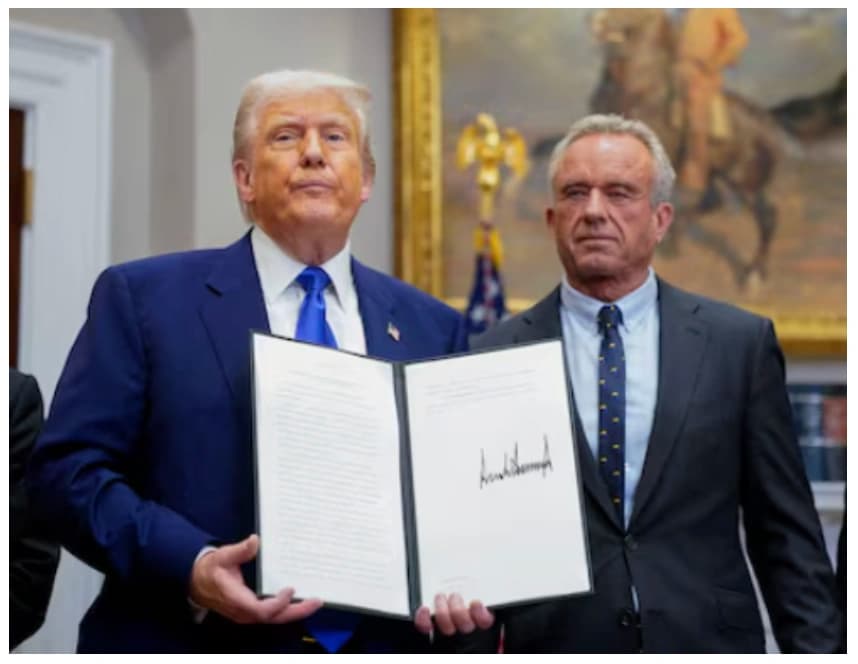
WAR ON DRUGS! Trump Takes the Fight to Big Pharma
For decades, Americans have been fleeced by Big Pharma, paying astronomical prices for life-saving drugs while the rest of the world gets the same medications for a fraction of the price. Democrats and left-wing activists, despite their loud promises, have utterly failed to tackle this crisis, bought off by pharmaceutical lobbyists who line their campaign coffers.

President Trump's Executive Order (EO) signed on May 12, 2025—is a seismic move to slash drug prices through a "Most-Favored-Nation" (MFN) pricing policy. This EO is a vindication of Trump's independence from the special interests and credentialed elites who've long protected Big Pharma's profits at the expense of everyday Americans. Here's why this is a game-changer.
America's Been Ripped Off for Decades
The United States, with less than 5% of the world's population, has been bankrolling 75% of global pharmaceutical profits, subsidizing research and development (R&D) for drugs enjoyed cheaply abroad. While Americans skip doses or go bankrupt to afford medications, other developed nations use centralized healthcare systems to negotiate rock-bottom prices. Consider these stark examples:
Insulin: A month's supply costs ~$100 in the U.S. but just ~$10 in France.
Ozempic: $969 in the U.S. versus $59 in Germany.
Eliquis (blood thinner): $606 per month in the U.S., compared to $114 in Sweden and $20 in Japan.
A 2022 RAND study confirms U.S. drug prices are 2.7 times higher than in other wealthy nations, with brand-name drugs costing 3.2 times more. This isn't just a pricing quirk—it's a deliberate system where Americans foot the bill for global innovation while countries like Canada and the UK ride free. Big Pharma claims high U.S. prices fund R&D, but a 2024 Public Citizen report reveals they spend more on stock buybacks and executive bonuses than on developing new drugs.
Meanwhile, Democrats like Nancy Pelosi and Joe Biden, despite years of rhetoric, delivered only token reforms, caving to Pharma's lobbying muscle. The Inflation Reduction Act's price negotiations? A drop in the bucket, covering just 10 drugs by 2026.
Trump's "Most-Favored-Nation" Revolution
Trump's EO flips the script. The MFN policy mandates that U.S. drug prices for Medicare, Medicaid, and even private insurance align with the lowest prices paid by comparable developed nations. Within 30 days, HHS Secretary Robert F. Kennedy Jr. will set price targets, urging manufacturers to comply voluntarily or face enforced caps through rulemaking. This is a bold push to lower costs across the board, potentially slashing prices by 30% to 80%, as Trump claims.
The EO also promotes direct-to-consumer drug sales, bypassing price-inflating middlemen like pharmacy benefit managers (PBMs). It tackles global inequity by tasking the Commerce Secretary and U.S. Trade Representative to stop foreign countries from suppressing prices below fair value, using tools like export restrictions or tariffs. If Pharma resists, the EO greenlights drug imports from low-price nations and threatens antitrust actions against anti-competitive practices, like delaying generic drugs. This is Trump unbound, taking on an industry that's long owned Washington's elite.
The Grift of Drug Ads: A Call to Action
Americans should not be taking a shopping list of drugs to their doctors based on what they saw on cable news the night before. HHS must ban drug commercials on TV. Then we'll see how big the grift really is. The U.S. and New Zealand are the only countries allowing direct-to-consumer drug ads, a $6.5 billion industry in 2022 that drives demand for pricey brand-name drugs. These slick commercials, flooding cable news with promises of better health, manipulate patients into pressuring doctors for medications they may not need. The result? Higher costs and overprescription, with Pharma laughing all the way to the bank.
A 2019 study found that 73% of the most-advertised drugs have low clinical value, yet they dominate sales. Banning these ads, as the X post demands, would expose Big Pharma's marketing scam and curb unnecessary spending. HHS should act swiftly to end this predatory practice, amplifying the EO's impact.
Why This EO Matters for Every American
This EO is a lifeline for the 30% of Americans who, per a 2023 KFF poll, skip doses or forgo medications due to cost. It's a rebuke to the Democrats and leftists who've postured as champions of the working class while pocketing Pharma's cash—over $1.2 billion in lobbying since 2010, per OpenSecrets. Trump's independence from these special interests shines through, proving he's fighting for the forgotten American, not the coastal elites or their credentialed allies.
The effects will ripple widely. Lower drug prices mean less financial strain for families, fewer tough choices between medicine and groceries, and a fairer system where the U.S. isn't subsidizing the world. While legal challenges from Pharma loom, and immediate cuts may take time due to rulemaking, the EO sets a bold precedent. It pressures foreign nations to share R&D costs, potentially reshaping global drug markets. For seniors on fixed incomes, workers with high-deductible plans, and parents of chronically ill children, this could mean thousands in savings annually.
Yet, the fight isn't over. Big Pharma's allies in Congress and the courts will push back, and Americans must demand accountability. Support leaders who back this EO, call for a ban on drug ads, and reject the lobbyist-driven status quo. This is the first step in a major fight, expect resistance!
🗳️ Answer Our Survey
Your Voice Matters
America's Most Trusted Survey Platform
Help us understand what Americans really think about today's most important issues.
Quick & easy - just 2 minutes
Join thousands of Americans